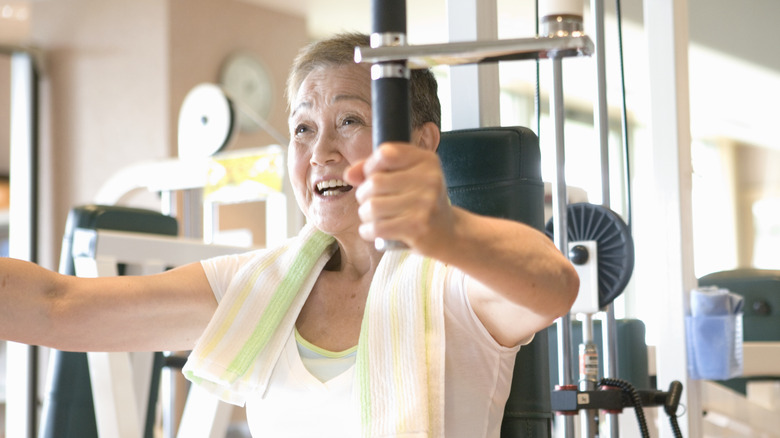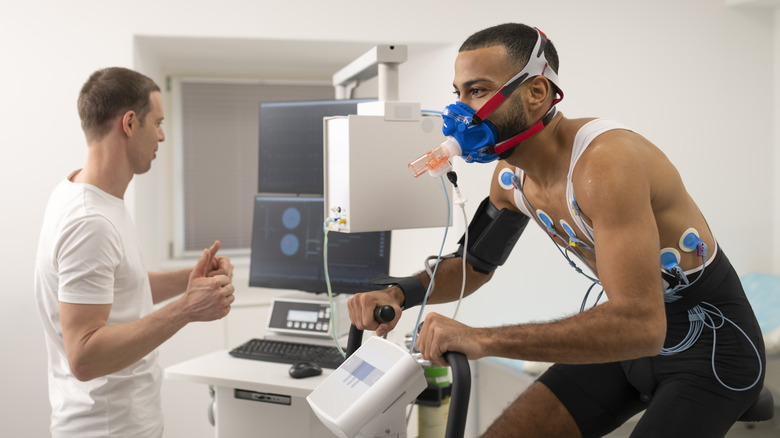Essential Tips To Help Find Your Fat Burning Zone
You're just getting into the exercise game, and you've been reading a lot about how important it is to achieve your fat-burning zone, especially for fat loss. But what is this magical zone?
Everyone has a unique fat-burning zone specific to their body, but essentially, this is the rate at which your body maximizes turning fat into fuel, according to Healthline. While the exact percentage varies based on where you look, Mount Elizabeth said it's about 70 to 80% of your maximum heart rate. Many gyms offer a fat-burning zone chart on the wall, but you can also figure this out with some mental math or by using the talk test as your guide. Additionally, some research shows your body is a good calculator for finding fat-burning zones. The exact numbers can be determined by a metabolic test at a medical facility.
Test out a few easy tips for finding your specific fat-burning zone to maximize your fat-burning potential. It's all about working smarter, not harder.
Use your heart rate and a little math
You don't need any high-tech gadgets to get a good idea of your fat-burning zone with the Fox formula, according to Healthline. Start with your age and subtract it from 220 to get your maximum heart rate. So, someone 47 years old would have a maximum heart rate of 173, since 220 minus 47 is 173. Since the fat-burning zone is about 70% of your maximum heart rate, you can then take the number 173 and multiply it by 0.70, which is 121. With this method, your fat-burning zone is about 121 for a 47-year-old.
With that said, lecturer Isaac A. Chávez-Guevara noted (via Insider) that this method might not be accurate since everybody is different. For example, a person who's a fitness buff might have a higher fat-burning zone than someone who's just starting. He suggests a more personalized approach by calculating your personal maximum heart rate. To do this, you need a heart rate monitor, either a chest monitor or a watch. Using a treadmill, keep upping the intensity of your walking or jogging pace until it feels draining. Check your heart rate and multiply it by 0.60 for your fat-burning zone. Someone with a maximum heart rate of 181 would have a fat-burning zone of 109. But Chavez-Guevara did note, "You do need to keep moving for more than a few minutes at that pace to burn a meaningful amount of fat."
Use the talk test as your guide
Not everyone has a heart rate monitor to rely on, and taking your heart rate can be irritating when you're focusing on working out. The National Academy of Sports Medicine (NASM) states that you don't need to rely on your heart rate to know if your body is in the fat-burning zone.
The talk test is an underrated guide that's perfect for beginners. When doing a moderate-intensity workout (like you need to reach your fat-burning zone), your breathing will be audible, but you can still hold a conversation, per the NASM. The Centers for Disease Control and Prevention also notes it wouldn't be possible to sing at this intensity.
To try this out, grab a friend and start working out. If conversation is impossible, you must take your intensity down a notch. If you can easily sing to that rock ballad you love, it's time to crank it up. Check in with yourself every 5 to 10 minutes to make sure your intensity is still at an adequate level.
Let your body be the guide
Research in 2022 published in Nutrients showed that your body naturally falls into its fat-burning zone when you complete an extended exercise. Within the study, participants were told to complete an activity at an intensity that they could hold for at least 45 minutes. The study showed that "training targeted at this level is efficient for reducing fat mass, sparing muscle mass, increasing the ability to oxidize lipids during exercise, lowering blood pressure and low-grade inflammation, improving insulin secretion and insulin sensitivity, reducing blood glucose and HbA1c in type 2 diabetes, and decreasing the circulating cholesterol level."
As Chávez-Guevara told the Washington Post, the human body is designed to maximize fat oxidation. Let your body be your guide for fat loss; the exertion you need to put in to reach your heart rate is lower than you think. According to Chavez-Guevara, it hovers about 3 miles an hour for most people. The next time you take a run or a walk, think less about looking at your fitness watch and more about letting your body do its thing to turn fat into fuel.
Try metabolic testing to find your precise fat burning zone
It's easy to calculate your fat-burning zone on your own, but it's not always going to be accurate. Several factors can come into play, making your fat-burning zone off, like medications and fitness level. Professional athletes and those who want precise measurements of their fat-burning zone can get metabolic testing.
According to UC Davis Health, you can complete exercise metabolic testing to measure how your body responds to different activities. During this test, participants' breath is monitored during training to determine their maximal fat oxidation, aka the maximum rate at which the body burns fat. The cost depends on the type of test that you have done and the facility, but it starts at about $50. You must contact a fitness or medical facility to schedule your test.
Healthline also notes that you can get a lactate threshold test done, sometimes in conjunction with the metabolic efficiency test. This test shows participants when lactate acid starts to build up faster than it can be removed, leading to fatigued muscles. All this information can help you find the best way to maximize your fat burn and stay injury-free.





